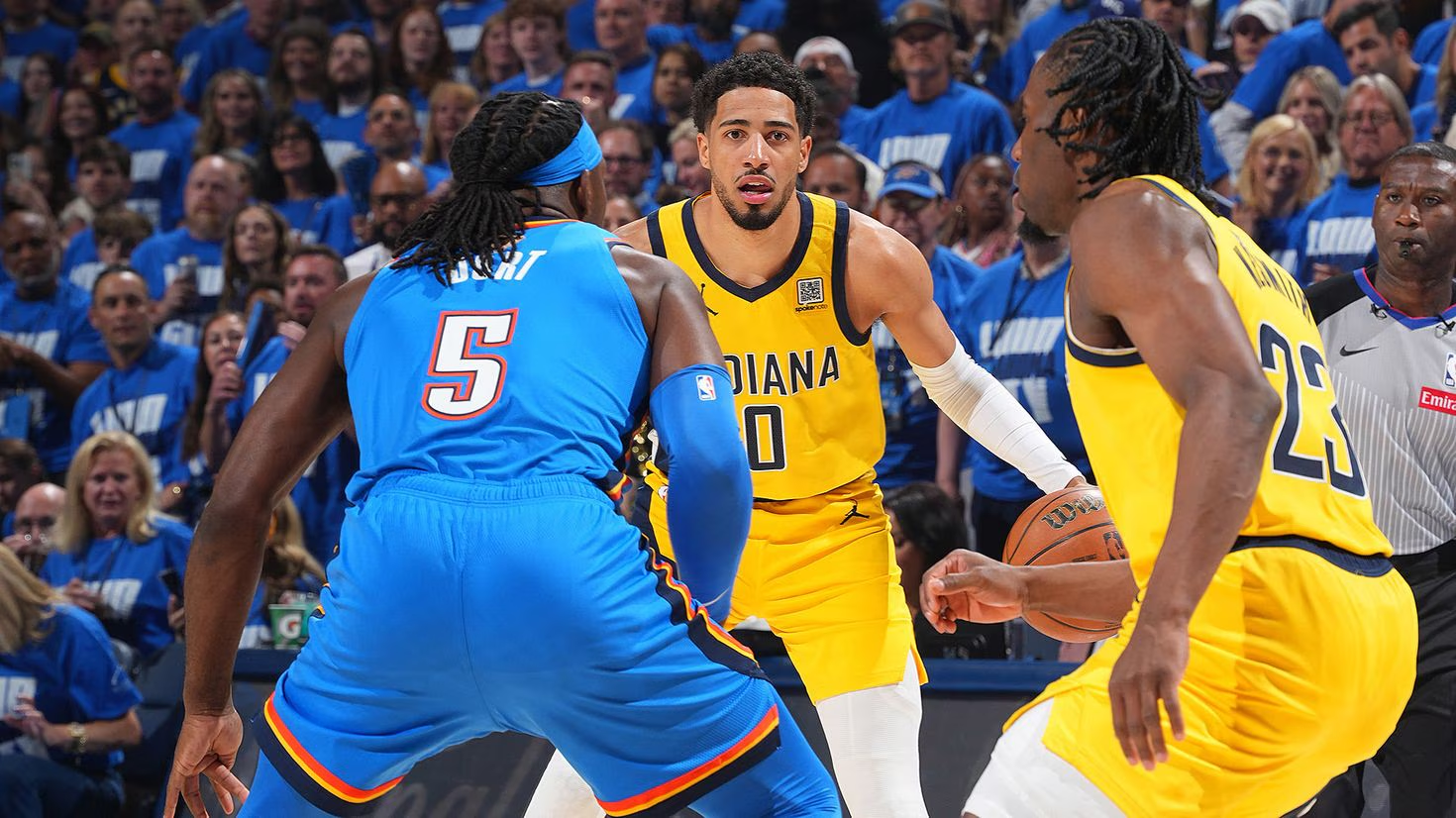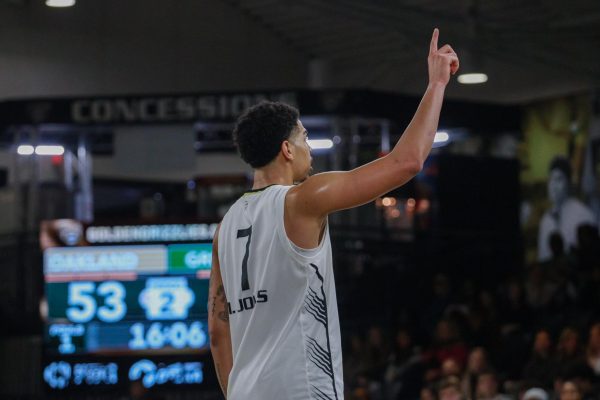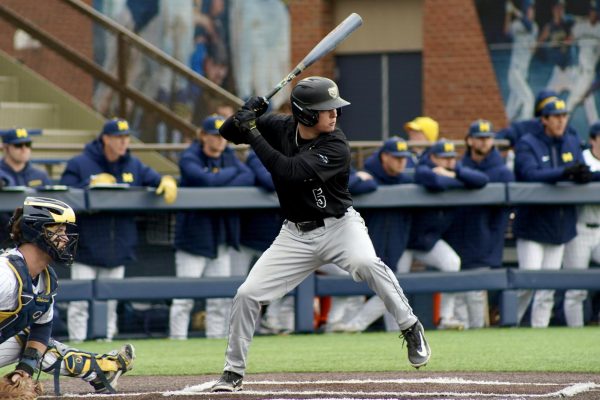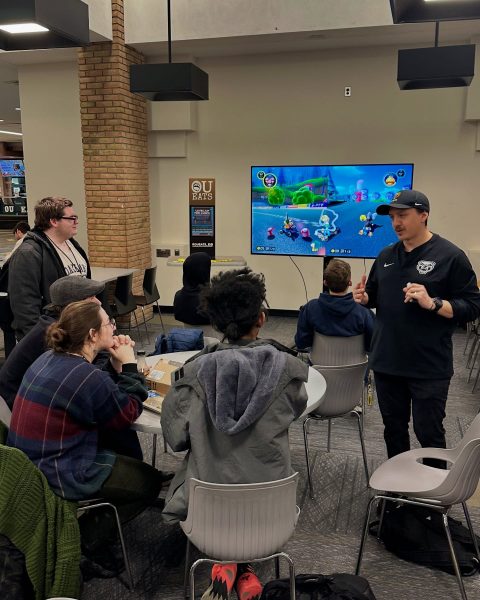Around the Summit League: North Dakota State
With the conference schedule starting in full-swing for the Golden Grizzlies men’s basketball team, The Oakland Post is debuting “Around the Summit League” to give some insight on conference teams.
In the first part of our new series, Bryan Everson spoke with Saul Phillips, head coach of North Dakota State men’s basketball team.
Led by their sophomores and new point guard Lawrence Alexander, the Bison excelled early with an 8-3 record, and face Oakland at home on Dec. 27.
Bryan: I think to some people around the Summit League, maybe not to you, but you guys have been the early darlings in the conference. Did you expect things to start so well?
Phillips: No I didn’t. I really have a talented group, but the top eight players in our rotation are freshman and sophomores, so there were a lot more questions than answers. Then we went into our first exhibition game, and we didn’t look very good at all. So you say to yourself, “Be patient.” And you go into that mode a little bit. But this group has defended better than I thought they could as a young group. I think that’s the catalyst for us; we’re defending better than I think we have been.
I thought this interview might be taking place a few weeks ago, so I was going to ask you how good (freshman point guard) Lawrence Alexander looked in the exhibition games, but I think that’s kind of been answered by his play in the games that matter. Elaborate on how much he’s meant to you guys.
Well the biggest thing with Lawrence is he’s made people around him better since he’s been here. The amount of easier shots he creates for others is the single biggest thing, but the composure with which he’s played as a freshman… he’s played beyond his years that way. I knew he had talent, but he’s far exceeded his expectations we had for him. He’s pretty well grounded, I’d expect nothing but for him to get better as the year goes along.
I think point guard was a spot where you guys didn’t have someone set in stone going into the year, and you got him to sure up those minutes. How does that make you guys feel going into contests like Oakland, Western Illinois, especially South Dakota State for you guys, teams with other real good point guards?
Mid-major basketball is a point guard-driven game. When we had success three years ago, we had a really good point guard. Certainly Oakland’s had a history of having really good point guards. (If) you look at the standings, it’s rare – not impossible, but rare – to have an elite team without a point guard. It’s important anywhere, but I think it’s magnified at our level. You’ve got to put someone out there at least who can off-set the other point guard a little bit.
Not to discredit South Dakota or North Dakota’s high school basketball, but I think Michigan’s got a stronger talent base. When you guys go out and recruit and produce successfully, do you attribute that to you and your staff going and combing over guys that other people are overlooking, or is that just you guys doing sort of what Oakland’s staff did with [former center Keith] Benson, a guy who isn’t highly recruited but has lots of potential?
Well, you certainly need to put a premium on finding kids without size. Then you need to develop them, there’s no question about that being a big part of our formula. Head-to-head recruiting wise, if we’re going to go out of the region, we’re going to come up short on some guys. There are some kids that North Dakota or Fargo just doesn’t appeal to. Now, usually, if we can get guys up on official or unofficial visits, they look around Fargo, and say, “This is a nice town,” or, “This is a nice university, it’d be a nice place to go.” But we fight battles trying to just get kids on campus at times because of perception. You’ve never been up here, but your perception of Fargo, I guarantee you, is way different than it actually is. It gets cold, but it gets cold in Detroit, and it gets cold in Milwaukee, Green Bay; it gets cold everywhere.
So you fight that a little bit, but your eye is always on kids that have a chance to grow. And we’ve been lucky that we’ve had kids come in and have done that. With this class, we had some kids that came in and were even a little more ready than we thought they were right off the bat.
Now Eric Carlson has been out with a broken jaw, correct?
Yeah; he had his jaw broke by an elbow to the face in the first exhibition game we lost. How’s that for a night? You lose to a D-II team and your jaw’s been wired shut since that time.
Has that made the quick start that you guys have gotten off to even more surprising?
It certainly wasn’t something that I accounted for going into the season. If you would’ve told me that we were going to lose him right away, I’d think that would’ve set us back a little more than it has. But it provided other guys to get minutes that they wouldn’t have, and they’ve done a good job.
He was a guy that, along with Michael (Tveidt) provided a lot of scoring for you guys two years ago, and then last year his minutes dipped while he increased his shooting percentage. What was the story there?
(Tveidt) was being guarded differently by other teams, and I think the scouting report caught up to him a little bit. Quite frankly, he hit a fairly major slump in the middle of the year. He was working through that, early returns looked good at the beginning of this year. He had worked on some of his weaknesses and gotten better. I expected him to kind of regain that form he had his sophomore year, and then this happened. He’s working his butt off to get back, but there’s only so much you can do when your jaw’s wired shut. He’s lost 15 pounds, and he still can’t eat solid food since Nov. 1. It’s going to be a process even when he’s cleared to play to get him back to full strength.
(Note: Carlson has since played two games. He logged 18 minutes against Mayville State on Dec. 18, and just seven Dec. 22 against Minnesota.)
Mike Felt was a spark plug before, and has been again in scoring this year. How has his development come along from what you expected last year?
The year before, he had a stress fracture in his foot and couldn’t do a whole lot even during the summer with it. So he kind of hit the ground not with the same level of conditioning under his belt, certainly not with the comfort in his game. He had some big moments and did some wonderful things, but he stayed healthy this entire summer, and that made all the difference in the world for the kid.
And he’s in unbelievable shape. A kid like that, like [Travis] Bader for Oakland, who relies so much on their movement without the ball and getting themselves open; if you’re not able to make those hard cuts the entire game, your success is going to be limited. This year, you get tired watching him out there. He puts defenses through the paces moving without the ball, and really sets the tone for everything we do offensively.
Dillon Hale is another guy you got in this year after sitting out. Is he another guy that would be seeing even more minutes than he is now if you guys hadn’t had the guys step up that you have already?
He’s been a very good defensive player for us early. He’s very quick, he can guard the ball, and he’s been very active causing turnovers. Whether it’s directly off the steal, getting into passing lanes or deflections, his role has been primarily a defender. So, his minutes have been earned on that end of the court. He’s capable of shooting it better than he has been, but honestly that hasn’t been worried me a lot. As long as he’s giving us the defensive production he has, he’s been really good that way for us.
I notice you guys used Taylor [Braun], it appeared at least from box scores, at the two-guard in Canada, and then started him at small forward in exhibition games. How have you guys juggled the matchups in terms of finding the right combos with a young group?
You know it’s funny, but a lot of that was dictated by the Carlson injury. When we were in Canada, Carlson was starting at the 4 and Taylor was starting at the 2. With Carlson going down, we had literally two 4s and two 5s. So, you had to shift him over to the 4 more often because of foul trouble, or because of potential foul trouble. He’s embraced that role; he’s done a real good job with it. It’ll be nice when Carlson gets back to have a little more flexibility in what we can do with him, but at 6-7, it can be a little bit of a matchup problem, and being able to shift him to different positions only makes him a more important player. Again, that hand was kind of played when we lost Carlson, but it’s served us well.
Last year’s freshman class of TrayVonn (Wright), Marshall (Bjorklund), and Taylor were all a big part of the success you achieved in conference play. What were your expectations of that class coming in and how they’ve lived up to or surpassed them?
Well, Marshall was recruited pretty widely by a lot of people, clear to the end of his senior year. So my expectations were pretty grand going in. He’s not flashy; he’s not a Benson-highlight film kind of center, where’s he’s going to have that signature block or big dunk. He’s just really steady and solid, more along the lines of a [Will] Hudson than a Benson. But my expectations of him were pretty darn high given what he’d accomplished back in high school and in AAU ball.
TrayVonn is a guy that we recruited 100 percent on potential. He played AAU ball with (North Carolina forward) Harrison Barnes and (Creighton forward) Doug McDermott, so he played with some really good players in AAU. What we saw was just a really long, athletic kid. The more we got to see, the more we liked. But with his frame, we were weary of how productive he could be his first year. He was certainly a redshirt candidate until very, very late in the process, so we could put him in the weight room and get some weight on him. He played too well and we ended up having to pull the redshirt off of him. I knew as soon as he started to be around and develop his body he’d start getting more results on the court.
He’s showed unbelievable glimpses; he was really good against IUPUI the other night, and very good against Northern Arizona out in California. He’s also had some nights where he’s disappeared a little bit, but he’s a sophomore. Of all my kids, he’s probably one of the better listeners in terms of trying to apply what is we’re teaching him. I still think his best days are in front of him.
With Taylor, he’s a kid that came in and redshirted, and he was just overlooked. Nobody really wanted him out of the Portland area, but he liked his skill set along with his size. When we got him, I really liked his personality, and he’s really become an emotional leader on the team. He gives us a confidence…a little more of a swagger than maybe we’ve had in the last couple of years. He’s really been considered an emotional anchor of this team. Somewhere in the middle of his redshirt year I thought he’d be pretty good.
Given their athletic ability and their length, just the physical attributes, it doesn’t shock me that they’re doing what they’re doing, but I do think it’s a pleasant surprise that they’re doing it so consistently at this point.
At what point in this year during the early string of victories did you see things coming along faster than you’d anticipated?
Really, San Francisco was a good test for us off the bat, because they had five returners from a team that won 19 games last year. They were always pretty good at home, they beat Gonzaga at home. They had two All-Conference guards in the West Coast Conference we were playing against. When we beat them I thought to myself we could be OK. Quite honestly, with a group this young, it hasn’t been easy for me to anoint this as being over the hump at any point. It’s been more of a, “Let’s get better and see what happens” mode. We had a lot of confidence in this group that eventually they’d be, but I see a lot of room for improvement. Getting off to a good start record-wise, it hasn’t been as comfortable as t probably should be for a head coach. It’s been more of a work in progress.
What are some of the things you’re seeing on the floor you want to see improvement from?
We turned the ball over 41 times in two games this past weekend. That is a long, long way from where I’d like to be. Our half-court offense, at times, bogs down a little bit. We get away from going into the post for long stretches of times, or we don’t screen effectively for periods of time. It’s all in that there are just 30-some practices with these guys, and I’ve got to remind myself of that. There hasn’t been a game on tape where I’ve gone through and said, “Yep, that’s where I want to be.” It’s been more that we’ve done this or that better, but maybe we took a step back in another area. The big key is trying to keep a young group’s confidence up when you’re constantly trying to make corrections and get them better. They’ve done a really good job of that, and certainly winning has helped a little bit. Their eagerness to learn has impressed me.
You guys renewed an old rivalry with USD (South Dakota) this year, and I don’t believe you’ve met since 2003-2004. What’s that going to be like getting to face them, even maybe with having some of the two state’s high school players and recruits factoring in?
Well we certainly go head-to-head with all the Dakota schools quite often [in recruiting]. I think the thing, for someone from Michigan that is probably harder to understand with the intensity of the rivalry, is that for USD, it’s they are more focused on South Dakota State and the rivalry there. It’s not quite as bitter between us and USD, but the South Dakota State-South Dakota game will be absolute bedlam. But there are bigger crowds at the games; the games are generally on TV in the Dakotas. There are a lot of people that grew up watching our program and their program play and are very familiar and kept up with the programs. It’ll be a pretty unique setting; Oakland certainly commands a lot of attention just because of who they’ve been. Oral Roberts is the same way. You go on the road a lot of times in the Summit League and play to a fairly quiet gym, but that won’t be the case when the Dakota schools play each other. It’ll be nasty as far as fan environments, but that’s fun; you like to play in those environments.
What did you guys throw at (IUPUI guard/forward) Alex Young when you faced him? He’s struggled early on in some of his starts early in games this year?
He was trying to do a lot off the dribble early on, and we didn’t do anything all that special, but we were certainly mindful of when he had the ball and providing help in the right spots. There wasn’t a double team or any special wrinkles per say, but I think one of the things we emphasize is help is in the correct location when he shoots. He’s tremendously gifted and can score in so many ways: in the post, off the screen and roll, from three, off the offensive glass. He’s a very underrated offensive rebounder. But I think some of it’s got to be that he had an off night, and I don’t think we can anticipate that the next time we see him.
I don’t know many better guys to ask about (South Dakota State guard) Nate Wolters; I feel like he deserves more people talking about him. What makes Nate so special?
He draws so many fouls. He’s surrounded by good shooters and is such a good passer; he sees the court so well and makes good decisions. I think what separates him from a lot of the other good point guards in the Summit League is the amount of free throws he shoots. You think you’re doing a pretty good job on him and you look up, and he’s got 20 points, and 10 of them are at the line. That has a lot of effects on you; it gets you into foul trouble, and all the sudden, you’re playing with your second-string point guard. He makes people around him so much better, and that’s rare to do for a guy who scores as much as he does, but he pulls it off. He’s got unbelievable handles on the basketball, and unbelievable vision. And with his size, he creates shots at times that maybe he shouldn’t be able to. He’s absolutely made the most of every opportunity he’s gotten; he’s a good player.






